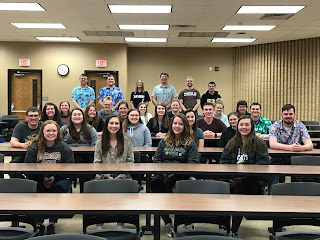19May2019
The SDSU students started off their day eating breakfast at
their farm host house. Breakfasts included omelets, bacon, coffee, tea,
different jams, and of course some good ole’ Vegemite. I think most students
would say the vegemite was not a fan favorite. The students then made their way
back to the Millers Flat town hall to gather before we made our way up to
Avenel station. The students got to hop in the back of 4x4 vehicles of their
farm stay hosts and maneuvered through the hills to make their first stop of
the day. Arriving at the station, the group was greeted with tea, coffee, and
some pastries. At the station, we were introduced to Nick and Dave where Nick
gave us a rundown of the operation. They started the operation in 1965 with
around 11,000 acres and formed a partnership up until 1989, and have since then
reduced to 5,000 acres which are now run by three cousins.
 |
| Nick
explaining the operation to the group |
 |
| Herding
sheep up the hill |
They currently run 4,800 mostly crossbred sheep and 300 head
of Hereford Angus cross cattle. The operation runs by lambing in late spring
which is the end of October. In addition, they calve in late September. Some
challenges Avenel Station faces is the birth of triplet and quad lambs as one
ewe only has two teats. The lambs that are typically born in threes or fours
are fragile and underweight and cannot survive like singles or twins. The
lambing percentage is 140%. The operation also takes pride in maintaining the
sheep condition scores by measuring four times a year. They do this by placing
their hand on the ewes back.
 |
| Students
looking at Dave’s cattle |
The Avenel Station sits at 3000 feet and still receives a
lot of snow in the winter. The station has only around three weeks of snow
during the winter. Calves are wintered on fodder beets and are given
supplements for around 160-170 days. They aim for 90% calving rate, and they
have to supplement iodine and selenium because their soils in that area are
deficient. When cropping, their first season is under no cultivation and
brassicas are planted and then for the second season they cultivate and plant
either fodder beets or kale. They apply fertilizer in the springtime which
includes sulfur and phosphate which is very important. They also apply a
maintenance fertilizer by plane of glyphosate which is important because it
reduces the amount of tillage needed.
 |
| Dave
and his cattle dogs herding last year’s calves |
 |
| One
of the Moeraki Boulders |
Our next stop was in Dunedin for lunch. The town was settled
by Scottish immigrants in the 1800’s. We were running quite a bit behind
schedule so we only had 15 minutes to eat! From there we went to see the
Moeraki Boulders which are stones on Koekohe beach that have been smoothed,
worn down, and rounded by constant erosion from the waves hitting them and it
took them 4 million years to get to their current size today!
 |
| The
waves hitting Moeraki Boulders |
We then made our way to Oamaru where we got the chance to
see the Little Blue Penguins!
 |
| Little
Blue Penguin (Google credit) |
Unfortunately, we were not allowed to take
pictures due to the birds being highly sensitive to flash photography. They
leave in the early morning before sunrise to spend the day in the Pacific Ocean
fishing for small fish and squid to eat and bring food back for their babies.
They then return to land after dusk. The penguins live to be about 8-10 years
old, weigh around one kilogram (2.2 lbs), and are around 30 cm tall. During the
day, they will either stay hidden in their nests or go out to sea. Everyday,
they travel out around 45-50 kilometers and back.
 |
| Calissa, Abby and Brooke pose for a photo at the Blue
Penguin visi |
To end the night, we all made our way to the hotel for the
night where we all ate dinner separately and have been winding down the trip to
head home in a couple days. We are all very tired and ready to be back!
-
Kaelyn and Connie











Comments
Post a Comment